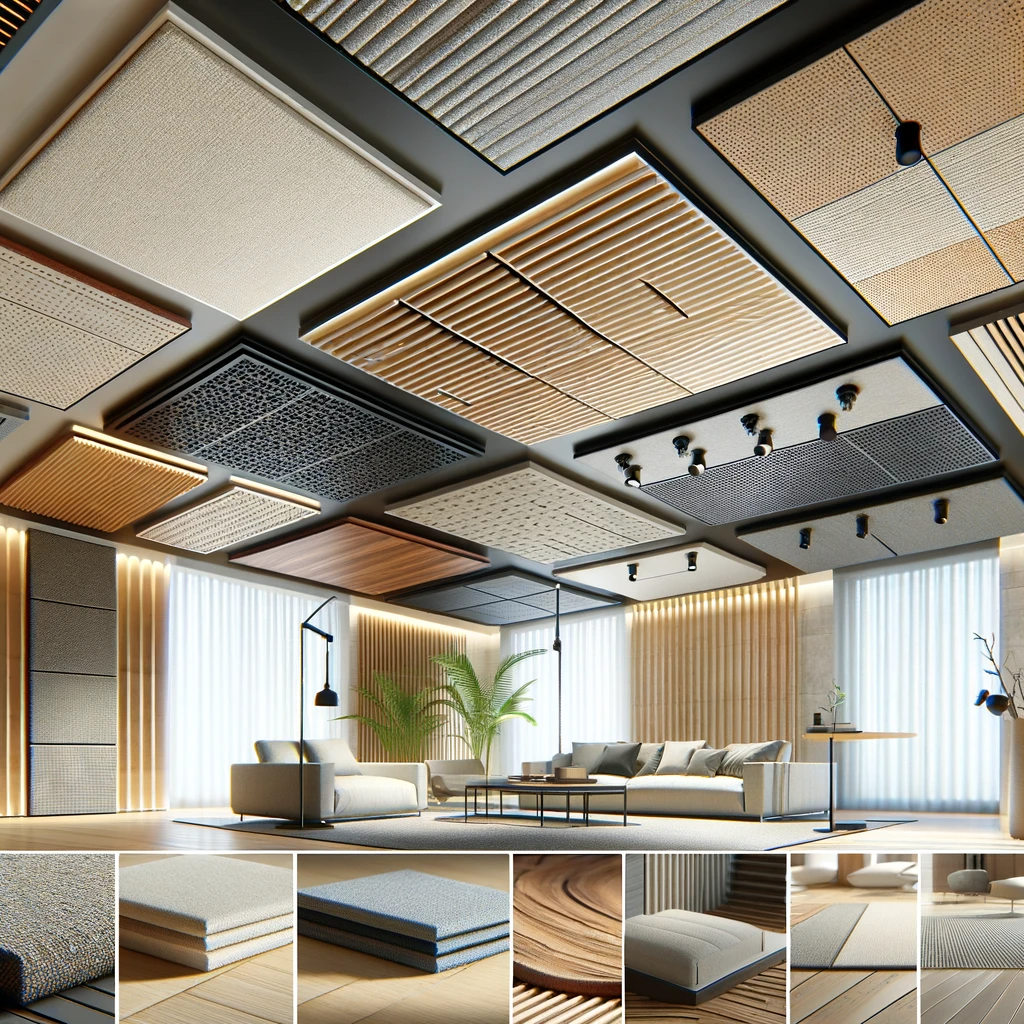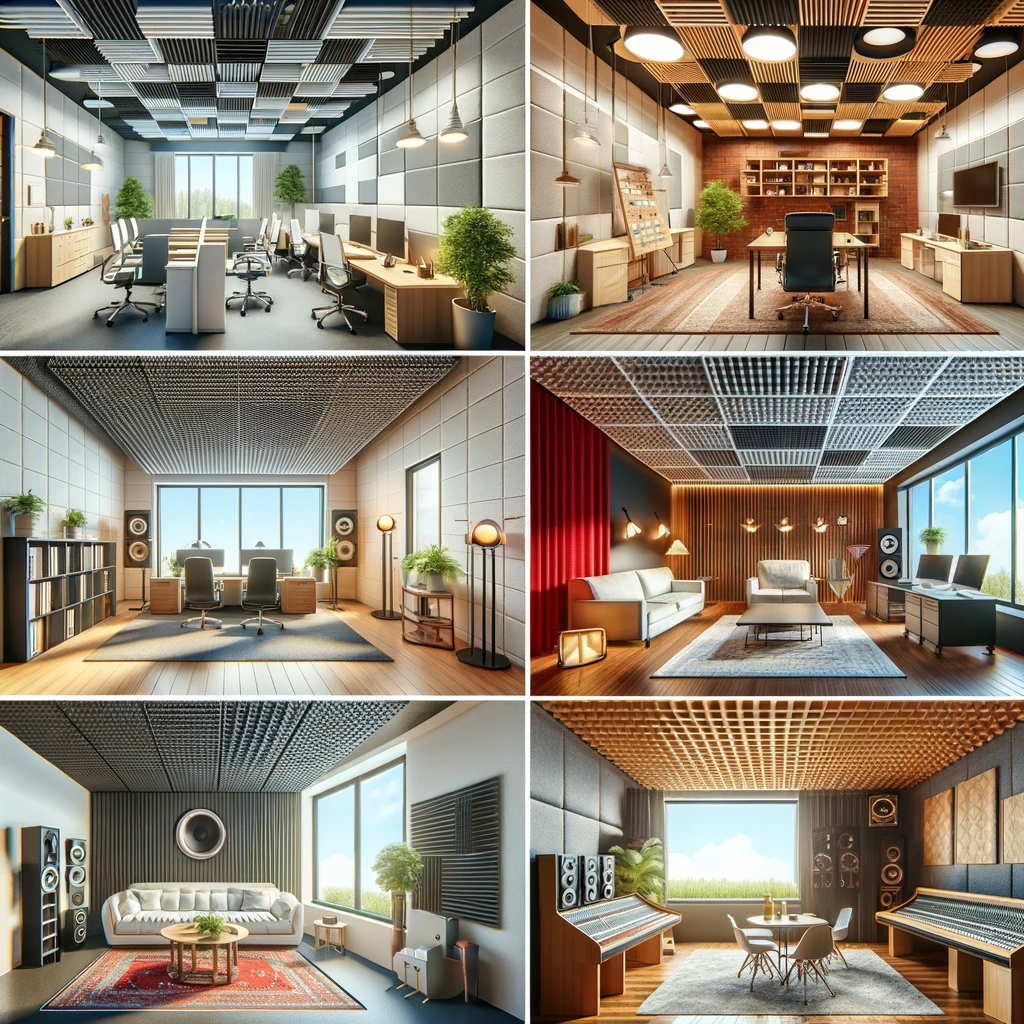Struggling with noisy echoey rooms? Acoustic ceiling panels help absorb sound for better clarity.
Acoustic ceiling panels are customizable sound-absorbing tiles installed onto ceilings to reduce ambient noise, echo and reverberations.
Let’s explore what materials acoustic ceiling panels use, types available, benefits they offer, spaces that use them, considerations for choosing panels, and how to install them properly.
What Are Acoustic Ceiling Panels?

Acoustic ceiling panels are sound-absorbing panels installed onto ceilings to reduce noise, echo and reverberation within a room.
Typically made of porous materials like fiberglass or mineral wool covered in fabric, acoustic ceiling panels utilize their sound dampening properties to optimize room acoustics.
To understand more about acoustic panels and how they work, read What Are Acoustic Panels, What Do Acoustic Panels Do And How Do Acoustic Panels Work?
Now let’s explore more details on acoustic ceiling panel materials, types, benefits and installation below.
What Materials Are Acoustic Ceiling Panels Made From?

Acoustic ceiling panels are manufactured using a variety of materials, each with their own unique properties, advantages and disadvantages.
Some of the most common materials used to construct acoustic ceiling panels include mineral fiber, fiberglass, wood, metal and plastic.
Mineral fiber is one of the most prevalent materials utilized in the production of acoustic ceiling tiles and panels.
The fibers, which may be composed of rock, slag or glass wool, are bonded together by adhesives to form semi-rigid or rigid panels known as mineral fiber panels.
One type of mineral fiber panel is mineral wool panel, which uses fibers made from basalt rock or steel slag waste products from steel manufacturing.
Mineral wool ceiling panels are highly effective at absorbing sound waves and noise due to their fibrous structure which helps dissipate acoustic energy.
Additionally, mineral wool acoustic panels provide thermal insulation and fire resistance, making them suitable for use in building interiors.
Fiberglass acoustic ceiling panels are another popular acoustic treatment option constructed from fine interwoven glass fibers. Read more to know if fiberglass acoustic panels are safe to use
Like mineral wool panels, the fibrous composition of fiberglass allows it to effectively absorb sound waves and reduce noise and echoing.
Fiberglass panels are also lightweight and simple to cut, install and clean.
However they may require additional fabric wrapping or coating to prevent glass fiber exposure and skin irritation.
Fiberglass ceiling panels also deliver thermal insulation by slowing heat flow which helps regulate indoor temperatures.
For applications where aesthetic visual appeal is a priority, wood paneling can provide an attractive, natural look when utilized for acoustic control on ceilings. “Do Wooden Acoustic Panels Work?” provides more insights on this material.
Wood naturally deflects some sound waves while its porous physical composition allows other sounds to permeate into the material, dampening reverberations.
Perforations drilled into the wood further aid with acoustic absorption. Understand more to learn how perforated acoustic panels work
Real wood veneers, laminate wood composites and perforated hardwood panels are options for wooden acoustic ceiling panels.
Metal ceiling panels present another option when higher durability, moisture resistance or fire resistance ratings are required.
Metals like aluminum, galvanized steel and tin can be formed into panels and perforated with small holes or vertical channels to help scatter and absorb sound waves rather than purely reflecting them.
This allows metal panels to provide both decorative visual appeal and acoustic control.
Metal finishes like brushed steel, copper and chrome allow for contemporary designer looks whereas powder-coated and corrugated panels offer budget friendly solutions.
Finally, plastic ceiling tiles constitute one of the most cost effective acoustic ceiling materials.
Typically made from recycled polyester fibers and other plastic materials, plastic ceiling panels are water and moisture resistant but have limited sound dampening capabilities relative to denser materials.
However their light weight, affordability and ease of installation make them a practical option for basic do-it-yourself acoustic upgrades.
Their sound absorption can also be enhanced by layering them with acoustically transparent fabric.
What Types of Acoustic Ceiling Panels Are Available?

Several varieties of acoustic ceiling panels exist to match different visual design tastes, performance acoustic needs and budgetary constraints.
Some common types include fabric wrapped panels, paintable panels, wood panels, metal panels and plastic tiles.
Fabric wrapped acoustic ceiling panels… For more on fabric choices, read What Fabric For Acoustic Panels Should You Choose?
Material choices for the wrap include microfiber, polyester, linen, cotton, vinyl and microsuede fabrics.
The fabric facing is available in a vast spectrum of colors to coordinate with room paints, furnishings and lighting fixtures.
Fabric wrapped panels provide sound dampening from their interior absorption core and an attractive exterior appearance.
For seamless visual integration, paintable acoustic panels come pre-primed white so they can be custom painted on-site to match any wall or ceiling color precisely.
This allows the panels to visually blend into drywall surfaces for very discreet noise control.
Paintable panels still utilize an interior core of acoustic absorbing material to reduce echo and reverberation.
Genuine wood veneers, laminate wood composites or perforated hardwood panels deliver beautiful warmth and sophistication without sacrificing acoustic performance.
Wood inherently blocks and absorbs some sound waves while their porous and multi-density structure dissipate reverberations.
Perforations also aid performance. Real wood acoustic ceiling panels promote ambiance in studios, theaters and performance spaces.
Metal ceiling panels use acoustically transparent perforated metals to allow absorption from underlying insulation while benefiting from the elegant visual and durable properties of metal finishes.
Choices range from aluminum and steel to copper and tin panels with unique hole shapes and patterns like circles, diamonds, slots or squares that scatter sound.
The style suits modern contemporary and industrial interiors.
Finally, plastic ceiling tiles offer budget friendly acoustic options. Though plastic inherently reflects sound, accompanying insulation insert layers assist absorption.
Plastic panels come in white or black and install easily. Despite simple noise reduction capabilities, the low cost facilitates basic acoustic upgrades.
What Are the Benefits of Installing Acoustic Ceiling Panels?

Upgrading to acoustic ceiling panels in lieu of drywall or concrete ceilings carries multiple beneficial enhancements to room sound, functionality and aesthetics.
Most importantly, acoustic ceiling panels effectively absorb sound waves and noises within a room instead of reflecting them which reduces troublesome reverberation and echo issues.
This in turn optimizes speech and music clarity, allowing better intelligibility without noisy amplification.
Well designed acoustic ceiling panels come in stylish materials from ornate woods to sleek metal finishes that match diverse decor tastes for enhanced aesthetics compared to basic drywall or concrete.
Custom painting and fabric wrapping further widens decorative options.
The panels conveniently install into standard drop ceilings by simply laying atop existing gridwork. Other systems use adhesive strips or wires allowing flexibility.
This accessibility also maintains easy lift-tile plenum access.
Many acoustic ceiling panels utilize inherently insulating materials like fiberglass or mineral wool.
This augments thermal insulation against heat and cold allowing enhanced indoor climate control.
These materials also meet fire codes for flame resistance and retardancy which is especially beneficial in public spaces.
Ceiling panels come in common modular sizing but custom options exist for unique rooms.
Between effective sound absorption, pleasing embellishments, convenient installation and insulation benefits, acoustic ceiling panels discreetly yet significantly upgrade room functionality and ambiance.
The relatively simple upgrade through retrofitting or new construction suits most environments.
Will Acoustic Panels Help With Noisy Neighbors? explores the effectiveness of these panels in residential settings.
What Types of Rooms Commonly Use Acoustic Ceiling Panels?

Because of their ability to substantially enhance sound quality and clarity while reducing disruptive ambient noise and reverberation, acoustic ceiling panels widely install in office spaces, conference rooms, home theaters, recording studios, restaurants, schools and more.
In office settings including open floor plans, cubicles and individual offices, acoustic ceiling panels become valuable for absorbing extraneous noise that distracts workers.
Phone calls, conversations, photocopiers, computer fans and other equipment get muffled by the panels.
This augments productivity and focus while allowing better intelligibility for in-person collaborations and video conference meetings.
Panels also reduce noise transfers between neighboring workstations for respectful privacy.
Presentation clarity similarly improves in corporate conference rooms when acoustic ceiling panels control reverberation and background noises from ventilation systems that undermine speaker amplification.
Meetings can flow smoothly without continual repeating for inaudible phrases. Panels additionally facilitate confidential room conversations by preventing eavesdropping.
Classroom settings face analogous focus and comprehension challenges that acoustic ceilings help mediate.
To prevent disturbing other household members yet allow loud movie viewing clarity, home theaters rely on acoustic ceiling panels along with bass traps and insulation to contain sound leakage and minimize interior noise bouncing.
Recording studios demand professional grade acoustic treatment like ceiling panels to optimize isolation and echo reduction so production teams hear clean incoming vocal and instrument tracks unmuddied by bleed-through sounds from adjacent rooms.
In dining establishments, excessive noise from kitchens, machinery and overwhelming crowds detracts from meals whereas acoustic ceiling panels allow more intimate dining ambiance and easier table chatter.
The design approach holds true in hotel hospitality spaces.
School cafeterias also grow loud at peak times, undermining student interactions and potentially contributing to behavioral issues stemming from noise frustration.
Here too acoustic panels generate perceptible improvements.
What Acoustic Metrics and Other Factors Should You Consider When Selecting Ceiling Panels?

Choosing appropriate acoustic ceiling panels for a given room relies on assessing several key specifications, measurements and requirements in relation to the space and intended functionality.
One vital metric is the Noise Reduction Coefficient (NRC) which signifies a material’s effectiveness in absorbing ambient sounds rather than bouncing them.
An NRC of 0 denotes full sound reflection while 1 indicates total absorption. Acoustic panels carry NRC values from 0.5 up to nearly 1.0.
However higher numbers above 0.8 provide diminishing returns. Targeting between 0.6 and 0.85 satisfies most needs.
In addition, the total square footage requiring acoustic treatment must be calculated when determining adequate panel coverage and quantity for optimal noise control.
Installing into existing suspended grid drop ceilings also warrants checking panel weights comply with the grid load capacity to avert collapse.
Measuring present humidity and moisture levels helps dictate whether water resistant panels or membranes merit inclusion.
Safety codes also indicate necessary fire resistance ratings based on room occupancy and use.
Visual coordination with interior design aesthetics often sways product selection too.
Whether matching paint colors, complementing fixtures, incorporating artwork or cobranding a company logo on custom prints, ceiling panels should enhance decor when possible.
Similarly, regional building codes enforce durability, sanitation and sustainability aspects that panels must satisfy.
Light reflectance values also matter for coordinating electrical lighting so acoustic products don’t make rooms seem darker.
Understanding all these parameters facilitates choosing ceiling panels tailored to room requirements.
How Do Contractors and Do-It-Yourselfers Install Acoustic Ceiling Panels?

Three common methods exist for installing acoustic ceiling panels: overhead grid suspension, adhesive mounting and hung suspension.
The preferred technique depends on panel composition, weight and desired aesthetics balanced against installation complexity and room architecture.
For drop in simplicity without modifying overhead structures, installing lay-in acoustic ceiling panels atop existing exposed gridwork proves convenient.
Tiles or panels securely rest on grid ledge supports while gaining easy lift access to mechanical systems above the dropped ceiling.
This approach works best for lightweight mineral fiber, plastic or perforated metal panels under 2 pounds per square foot that won’t bend gridwork.
Alternatively adhesive mounting attaches panels directly against ceiling surfaces using panel adhesive caulking, double-sided tape strips with foam or synthetic rubber cores, interlocking Z-clips, magnetic squares and Velcro.
Adhesive provides the strongest bond with seamless panel integration but restricts later removal.
Velcro and magnets permit detachability though with less reliability over time. They also create subtle visible perimeter lines around panels.
Still these options prevail for concrete, plaster or drywall ceilings lacking suspended grids.
Finally installing hung ceiling panels with aircraft cables, T-tracks, threaded rods or picture rail hanging strips creates a floating cloud-like aesthetic when calibrated properly.
This requires precise panel balancing and more complex wire/hardware access above ceilings.
Yet the visual freedom and customizable arrangements merit the effort.
DIY homes may be limited to grid or adhesive mounting whereas professional AV teams handle complex suspended builds.
All installation methods still demand careful measurements marking locations coordinated with lights, vents and sprinklers.
Following manufacturer guidelines ensures suitable environmental conditions, approved mounting hardware and necessary perimeter spacing so vibrations don’t spread between panels.
Absorption performance and aesthetics both hinge on mindful planning and execution.
For a comprehensive guide on installation, refer to How To Install Acoustic Panels On Walls, Ceilings and Windows.
Conclusion
In summary, acoustic ceiling panels provide an effective way to reduce excessive noise, echo and reverberation in rooms of all kinds.
Made of sound-absorbing materials like mineral fiber and fiberglass, the panels dampen noises when installed properly onto ceilings.
With benefits like better speech clarity, customizable aesthetics, and eased installation, acoustic ceiling panels enhance functionality and ambiance discretely.
By understanding panel types, metrics like NRC ratings, and weighing factors like fire codes, moisture and decor, the right ceiling panels can be selected for specific spaces.
With some careful planning, both DIYers and professionals can install the panels through existing grids, adhesives or hanging structures.
Acoustic ceiling panels promise noticeable acoustic improvements to environments from offices to theaters to classrooms and beyond.
